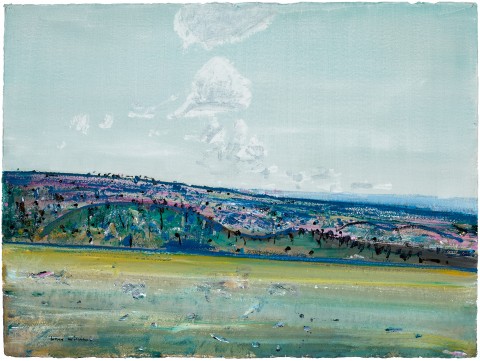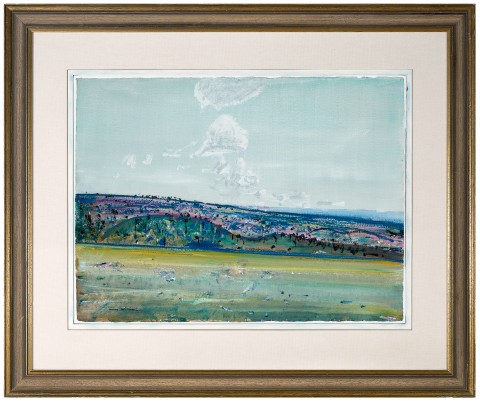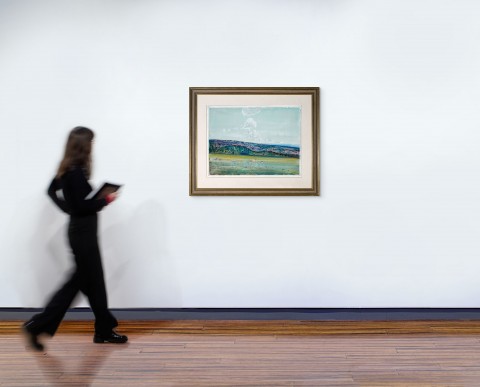AVENEL, 1971
FRED WILLIAMS
gouache on paper
57.0 x 76.0 cm
signed lower left: Fred Williams
Private collection
Lauraine Diggins Fine Art, Melbourne (label attached verso)
Private collection, Melbourne, acquired from the above 11 June 1999
Annual Collectors’ Exhibition 1999, Lauraine Diggins Fine Art, Melbourne, 5 June – 3 July 1999, cat. 95 (illus. in exhibition catalogue, as ‘Untitled Landscape’)
We are grateful to Lyn Williams for her assistance in cataloguing this work.
We are grateful to Brenda Martin Thomas, wife of the late David Thomas AM, for kindly allowing us to reproduce David's writing in this catalogue entry.
There is a spontaneity about Fred Williams’ gouaches that singles them out from the rest of his work. Painted outdoors directly from the motif, they have that freshness of first response, sparkling with light and atmospheric luminosity. Like drawing in paint, Williams explored the landscape and its potential for inspiring works. Sometimes painted in two or three strips on the one sheet of paper, or as a single view as in Avenel, 1971, the images captured in gouaches were frequently later developed into oils in the more considered atmosphere of the artist’s studio. Yet although interrelated and worked as a series inspired by the You Yangs, Upwey, Bega, and the Hamersley landscape, his watercolours, prints and paintings, nevertheless remain independent works in their own right. Despite Williams writing in his diary ‘...I only use the subject matter as an excuse to hang the picture on’, such pictures combine a particular sense of place with that of the archetypal Australian landscape.1 Thus, the oil, Red Landscape, 1981 (National Gallery of Victoria) is as much a part of his Pilbara series as being quintessentially Australian. And likewise, the twelve-sheeted gouache, Bushfire in Northern Territory, 1976 (National Gallery of Australia, Canberra) is the Australian bush on fire, no matter the location.
So it is with the present gouache, Avenel – one of the first landscapes Williams executed in the picturesque locale that was to so capture his attention during the 1970s. Situated in the Victorian wine country of the Goulburn River Valley, Avenel was settled in the 1830s by Henry Kent Hughes who named the area after a village in Gloucestershire, England. The Australian Avenel however, in the heart of Victoria where Ned Kelly famously lived for four years as a child, had little in common with the Cotswolds – the Strathbogie ranges rising steeply on one side, and extensive plains interspersed with trees extending for miles towards Nagambie on the other. Williams first visited the area in late 1971, staying with friend and fellow painter Rosemary Ryan, and her filmmaker husband, Patrick, at their sheep farm Glen Ogil, located in the hills above Avenel. Painted on the 19th November according to an entry in Williams’ diary2, Avenel encapsulates Williams’ characteristic tripartite division of the landscape perfectly, with the vastness of the foreground and incline flattened to horizontal bands and the majority of the composition dedicated to an immense expanse of billowing sky – touching on the infinite. Working in the more traditional landscape format, infinity is echoed in the line of the horizon, which would seemingly stretch forever if it were not for the confines of the picture’s space. Making a virtue of what others have seen as the monotony of the Australian landscape, Williams also reveals its intimate side. Although essentially an aerial view, through singular strokes of paint and scumbles of lyrical colour he reminds us of the detailed beauty that lies on the forest floor and in the endless varieties of eucalypt. From Avenel and Lysterfield to Weipa, herein lies the enchantment of our landscape and its unique interpreter.
1. Diary, 5 July 1970, cited in Zdanowicz, I. & Coppel, S., Fred Williams: An Australian Vision, The British Museum Press, London, 2003, p. 99
2. We are grateful to Lyn Williams for confirming this diary entry.
DAVID THOMAS


